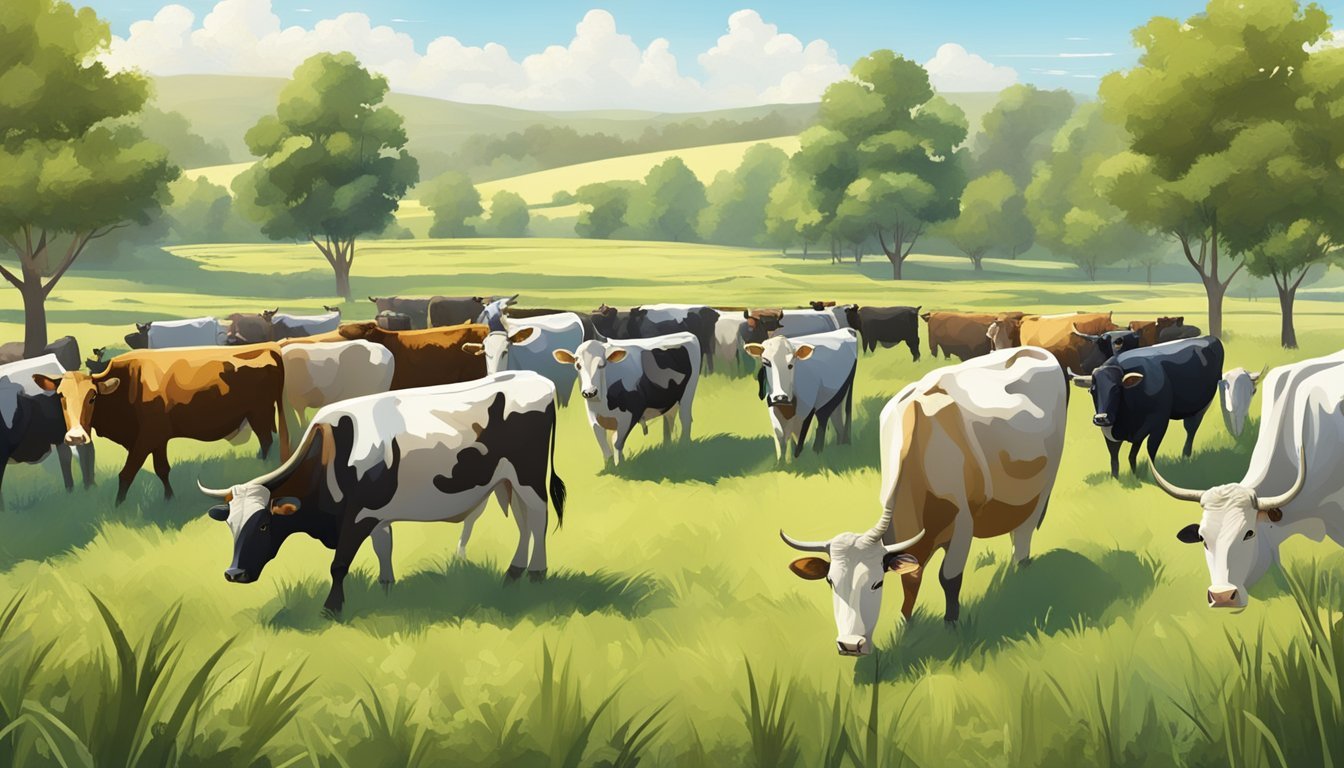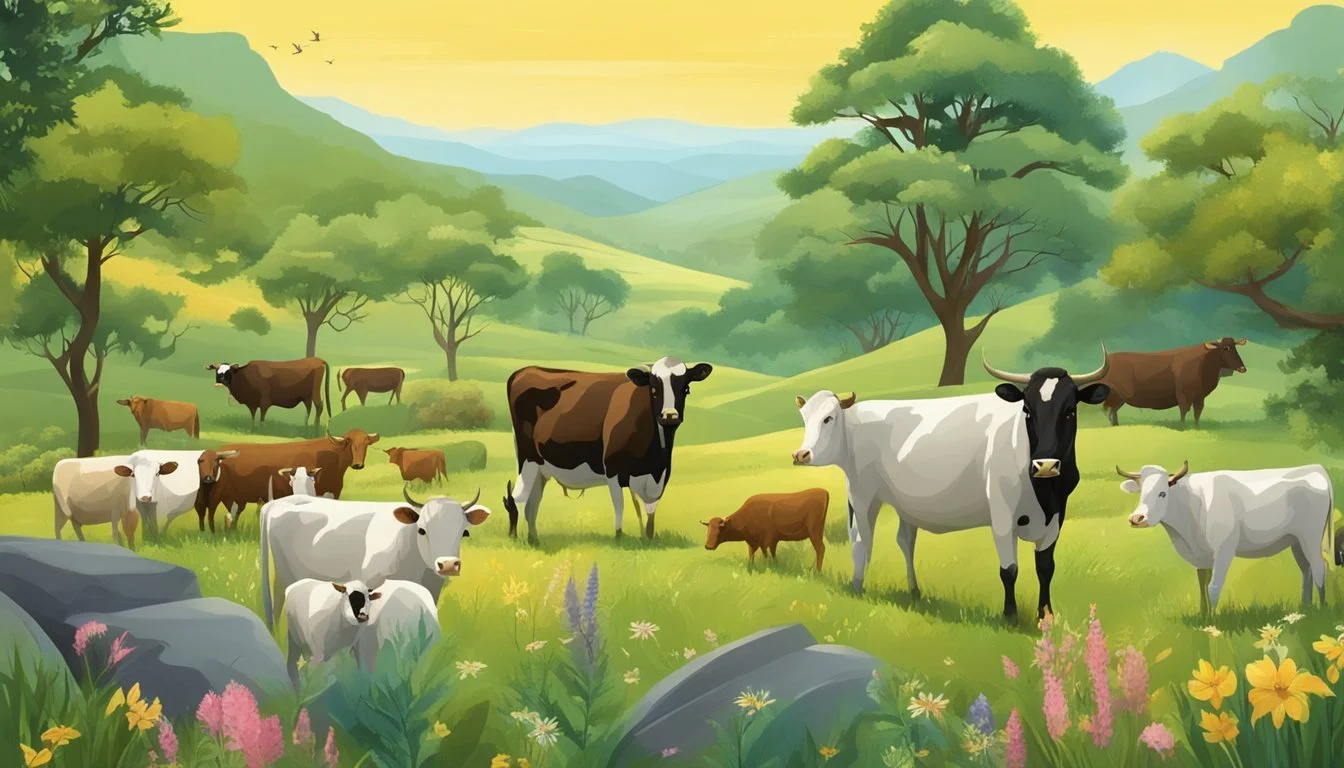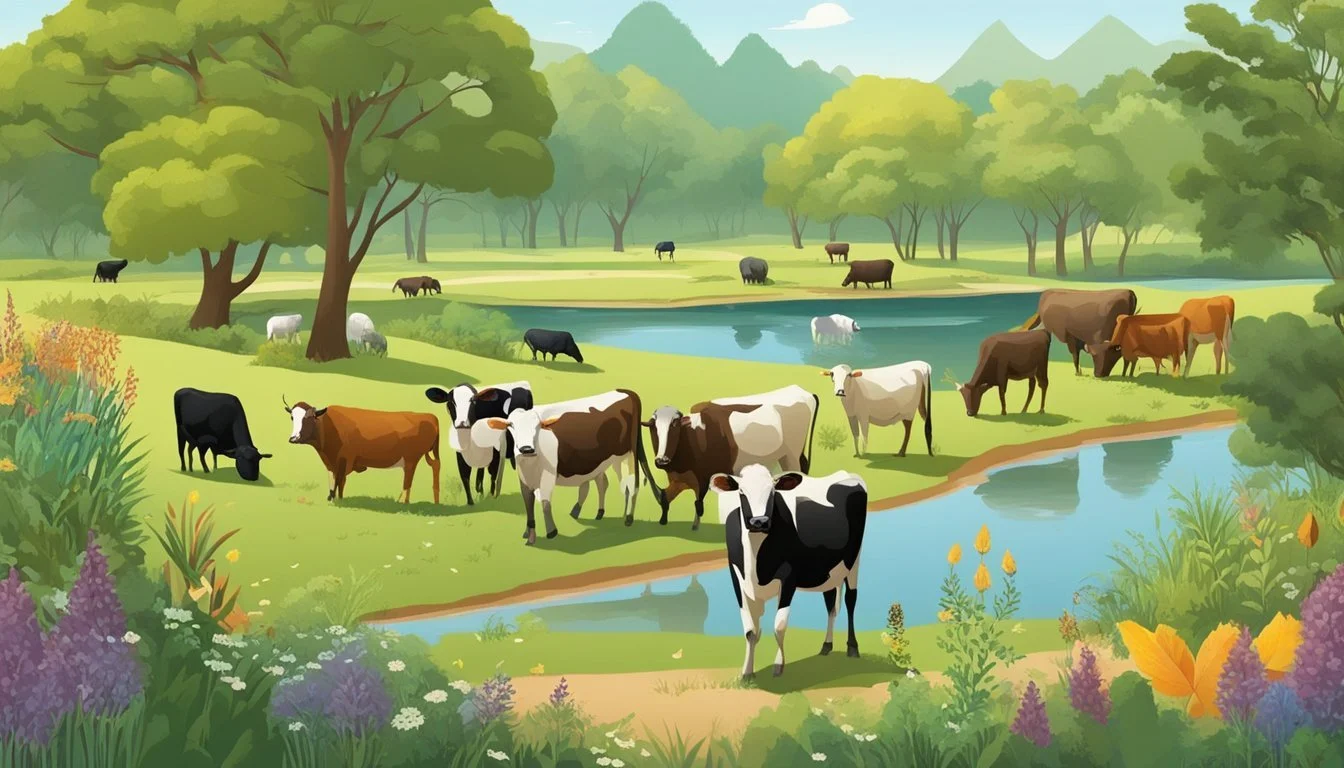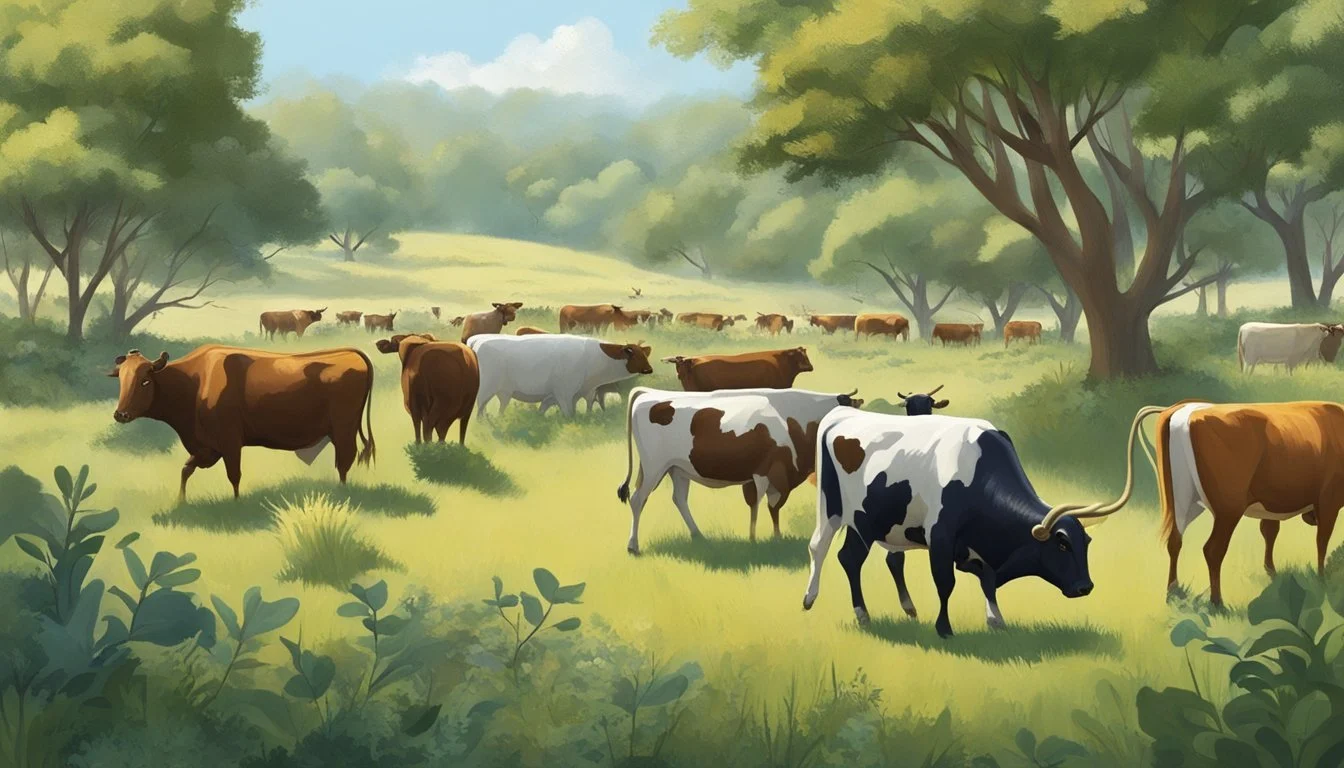How do I manage cattle to promote biodiversity
Strategies for Sustainable Grazing
Managing cattle in a way that promotes biodiversity requires an understanding of the balance between agricultural activities and ecological conservation. Livestock management and environmental protection are complementary when farmers and ranchers adopt sustainable practices. These practices ensure that commercial livestock operations contribute positively to the maintenance of ecological resources such as water sources, biodiversity, and feed production.
Biodiversity on farms is significantly affected by how cattle are managed. Practices that encourage diverse habitats can have beneficial effects on species variety and ecosystem services. For example, the presence of livestock, when managed strategically, has been known to have a positive impact on plant diversity and can help in maintaining a variety of organisms, which are vital for a healthy ecosystem.
Incorporating conservation efforts into livestock management not only supports biodiversity but can also enhance the resilience of the farming system. This includes strategic grazing methods, the restoration of native plant species, and maintaining wildlife corridors. These actions support a farm’s ecological parameters, including soil life and cover, water quality, and habitat connectivity, all of which are crucial elements in fostering a diverse and sustainable landscape.
Understanding Biodiversity in Cattle-Farmed Landscapes
Cattle farming can significantly shape the biodiversity of various ecosystems. This section explores how proper cattle management impacts species, habitats, and the productivity of ecosystems.
The Role of Cattle in Biodiversity
Cattle serve multiple roles in maintaining and enhancing biodiversity within farmed landscapes. As they graze, they can promote plant diversity by preventing single species from dominating plant communities. Additionally, cattle manure enriches the soil, supporting a variety of soil organisms that contribute to both soil health and plant productivity. Sustainable grazing practices can therefore enhance habitat quality for a range of species.
Impact of Livestock on Local Ecosystems
The presence of livestock, particularly when managed with an eye toward conservation, can help maintain diverse landscapes. A balance is needed to ensure that grazing intensity does not degrade ecosystems but rather enhances them. Appropriate stocking rates and rotational grazing can minimize negative impacts on local ecosystems and maintain a mosaic of different habitat types.
Benefits of Biodiversity to Cattle Farms
Diverse cattle-farmed ecosystems provide various ecosystem services including pollination, pest control, and nutrient cycling, which, in turn, can contribute to farm productivity. A landscape rich in biodiversity can also be more resilient to diseases and extreme weather events, safeguarding long-term agricultural productivity. Moreover, there is a cultural value to maintaining livestock biodiversity, as it reflects traditional knowledge and practices linked to land use.
Grazing Management for Biodiversity Enhancement
Effective grazing management can significantly enhance biodiversity by creating more diverse habitats and improving soil health. These methods involve strategic planning and regular adjustment to livestock management based on rangeland conditions.
Adaptive Grazing Techniques
Adaptive grazing is a responsive strategy where livestock managers closely monitor forage conditions and make decisions that support ecosystem health. By adjusting stocking rates and moving patterns, they ensure that forage plants are not overutilized, which allows for plant regeneration and sustains a diverse plant community. This approach optimizes the use of available nutrients, enhances plant growth, and supports a healthy ecosystem.
Rotational Grazing Practices
Rotational grazing involves dividing rangelands into smaller areas, or paddocks, and moving cattle between them in a planned sequence. This method prevents overgrazing, allows forage to recover, and promotes a mosaic of plant stages. Such diversity is beneficial for soil microbes and increases the overall resilience of the ecosystem. Managers schedule moves based on plant growth rates, balancing cattle needs with the recovery time of plants.
Grazing Intensity and Timing
The intensity and timing of grazing are crucial factors in the impact of livestock on biodiversity. Grazing intensity should align with the productivity of forage species to ensure that they are grazed sustainably. Timing is equally important; for example, grazing during a plant's growth phase may be more harmful than grazing during dormancy. These considerations are fundamental to maintaining diverse plant communities and the soil microbial diversity critical for nutrient cycling.
Promoting Flora and Fauna Diversity
Effective cattle management is essential to promote a rich tapestry of flora and fauna. By fostering plant diversity, supporting wild fauna, and incorporating perennial crops, landowners can create sustainable pastures that benefit both livestock and biodiversity.
Plant Diversity in Pastures
To enhance plant diversity, cattle managers should implement rotational grazing to prevent overgrazing and allow pasture recovery. This encourages a variety of plant species to flourish, each fulfilling a unique role within the ecosystem. Varieties of grasses, legumes, and forbs, in rotation, provide a habitat for pollination species and invertebrates.
Grasses: C4 and C3 species for seasonal coverage.
Legumes: Nitrogen-fixing plants for soil health.
Forbs: Crucial for diverse diet and ecosystem support.
Supporting Wild Fauna
Wildlife, including birds and invertebrates, thrives in environments rich in shelter and food sources. Cattle pastures can support this by maintaining hedgerows and buffer zones which serve as wildlife corridors.
Birds: Install nesting boxes; leave tall trees for perching.
Invertebrates: Conserve logs and leaf litter for habitats.
Incorporating Perennial Crops
Perennial crops sustain and improve soil structure while providing year-round cover for wildlife. They minimize soil disturbance, which helps maintain underground habitats for microorganisms and invertebrates.
Examples of Perennial Crops: Alfalfa, sainfoin, and chicory.
Benefits: Reduced erosion, improved water retention, and habitat stabilization.
By implementing these strategies, cattle managers can nurture an ecosystem that positively impacts biodiversity and agricultural productivity.
Conservation Efforts Within Cattle Management
Effective cattle management involves strategic actions that not only contribute to the productivity of livestock farming but also incorporate conservation principles to promote biodiversity. These practices protect wild species, enhance habitats for threatened species, and comply with relevant legal standards.
Biodiversity Conservation Planning
A well-structured biodiversity conservation plan forms the foundation of sustainable cattle management. Conservation planning often aligns with the guidelines of frameworks such as the IUCN Red List of Endangered Species. This involves mapping of grazing areas to sustain a variety of plant species, managing water resources, and setting aside conservation easements that protect natural habitats and corridors for wild species to thrive alongside cattle.
Protecting Endangered Species
Safeguarding endangered species through cattle management necessitates a species-based conservation approach. Actions such as rotating grazing areas help prevent habitat destruction and promote regrowth of native vegetation. Rotational grazing schemes, for example, give priority to areas that do not overlap with critical habitats identified under the US Endangered Species Act, thus ensuring that the needs of both livestock and wild species are balanced.
Legal and Ethical Considerations
Cattle management must adhere to legal and ethical considerations outlined in legislation such as the US Endangered Species Act. This requires ranchers to have thorough knowledge of endangered species on or near their land and to take proactive measures not to disrupt these populations. Ethically, farmers and ranchers must balance their economic activities with a commitment to maintaining biodiversity, which includes routine monitoring for signs of threatened species and adjusting management practices accordingly.
Integrating Cattle Production with Ecosystem Services
Integrating cattle production with ecosystem services can enhance rangeland productivity and water retention while promoting plant diversity and nutrient cycling. These practices not only support the livestock industry but also contribute to the health of the ecosystem as a whole.
Nutrient Cycling and Forage Growth
Cattle play a central role in nutrient cycling by transforming the forage they consume into manure, which is a natural fertilizer. This process enriches the soil with essential nutrients, promoting forage growth and improving pasture quality. Systematic grazing management ensures that manure is evenly distributed across the land, which supports diverse plant life and contributes to sustained livestock nutrition.
Water Retention and Soil Health
Well-managed grazing practices enhance the land's water retention capacity. The hoof action of cattle aids in breaking the soil surface, allowing water to infiltrate rather than run off. This not only prevents erosion but also facilitates deeper water penetration, promoting healthy root systems which sequester more carbon and improve soil structure. Such practices are essential for maintaining soil health and mitigating the effects of drought on rangelands.
Ecosystem Services Beyond the Farm
Cattle production provides a range of ecosystem services that extend far beyond the farm. Through integrated crop-livestock systems, cattle contribute to landscape-level benefits like enhancing biodiversity and reducing greenhouse gas emissions. By fostering habitats for various plant and animal species, cattle producers can manage landscapes in a way that balances productivity with ecological preservation.
Agricultural Practices and Biodiversity Maintenance
Effective management of cattle and crops is vital for promoting agricultural biodiversity. By adjusting our agricultural practices, we can preserve biological processes and enhance biodiversity on farmland.
Balancing Agriculture and Wildlife Needs
Agriculture and wildlife coexist in a delicate balance. To benefit both, one can implement buffer zones between areas of intense farming and natural habitats. These strips of land, often planted with native vegetation, can serve as corridors, allowing wildlife to move safely and reducing monoculture's impact. Practices such as rotational grazing can prevent overgrazing and soil compaction, encouraging a more diversified landscape that supports a variety of species.
Reducing Monoculture Impact
Monocultures, the practice of growing a single crop over a large area, can be detrimental to farmland biodiversity. They often require high inputs of chemicals and disrupt the local ecosystem's health. Introducing crop rotation and intercropping can maintain soil health and reduce pests and diseases naturally. By diversifying the crops grown, farmers support a wider range of species and biological processes, effectively reducing the negative impact of monocultures.
Sustainable Crop and Livestock Integration
Sustainable integration of crops and livestock on the same land is a practice that helps maintain agricultural biodiversity. Livestock can provide manure that fertilizes the crops, while the crops can offer feed for the livestock. This synergistic relationship creates a closed-loop system that can improve soil fertility and structure, increase crop yields, and strengthen the resilience of the farm's ecosystem. Integrating cover crops and pastures into crop rotations can also increase the diversity of plant life and the microorganisms that support them.
Addressing Challenges in Biodiversity Management
Effective management of cattle to enhance biodiversity involves overcoming a series of environmental and socioeconomic hurdles. Addressing these challenges is pivotal for maintaining ecological balance, ensuring species survival, and promoting sustainable agricultural practices.
Climate Change and Biodiversity
Climate change poses a significant threat to biodiversity, as it can lead to imbalances in existing ecosystems. As temperatures rise and drought conditions become more common, cattle producers must adopt adaptation strategies to ensure their herds and the surrounding wildlife can thrive. Employing resilient cattle breeds that are better suited to changing conditions can help preserve the integrity of the ecosystem. Implementing sustainable grazing practices is also critical to avoid overexploitation of pasturelands, which can lead to extinction of native species.
Handling Invasive Species and Pests
Invasive species and pest outbreaks threaten biodiversity by altering habitats and competing with native species. Effective pest management strategies are necessary to control these threats in a manner that is safe for both the environment and livestock. These strategies may include integrated pest management (IPM) techniques, which combine biological, cultural, and chemical methods to control pests efficiently while minimizing harm to other species.
Economic Viability and Biodiversity
Ensuring the economic viability of cattle operations while promoting biodiversity is a delicate balance. Biodiversity-rich farms can lead to increased profits through eco-tourism or by selling products branded as biodiversity-friendly. However, the adoption of practices that promote biodiversity, such as maintaining various habitats on the farm, may require initial investments. Financial incentives and market-based solutions can incentivize farmers to integrate biodiversity-friendly practices into their business models, contributing to a more sustainable agricultural sector.
Monitoring and Measuring Biodiversity on Farms
Effective biodiversity management on farms begins with establishing baselines and continuous monitoring to inform sustainable cattle management. Accurate data collection, technological tools, and community engagement are imperative for achieving these objectives.
Research and Data Collection
Initial research sets the groundwork for understanding the farm's ecosystem. Producers must conduct a thorough assessment of the flora and fauna across different habitats within their land. This might include mapping out various environmental features such as water sources, woodland areas, grazing zones, and hedgerows. For instance, the UK Centre for Ecology & Hydrology offers detailed guidance on setting biodiversity baselines. Quantitative data, such as species counts, and qualitative observations, like habitat health, need to be recorded systematically as references for future monitoring efforts.
Utilizing Technology for Biodiversity Tracking
Advancing technology has revolutionized biodiversity tracking on farmlands. Tools range from simple mobile applications to more elaborate satellite imaging systems. These technologies enable farmers to monitor changes in biodiversity efficiently and can highlight the success of management strategies or pinpoint areas needing attention. The deployment of drones for aerial surveys provides a bird's-eye view of ecological dynamics. It is vital to ensure that such technologies are used in a way that supports the publication of peer-reviewed research, advancing knowledge in the field of farm biodiversity management.
Community Involvement and Awareness
Finally, promoting community involvement plays a crucial role in biodiversity monitoring. Educating the local community about biodiversity goals and inviting them to participate in data collection can deepen the understanding of local ecosystems. ARDCorp's guide on Developing a Biodiversity Management Plan underscores the value of consistent and repeatable community-based monitoring. Ensuring community investment not only aids in the collection of meaningful data but also fosters an inclusive approach to environmental stewardship.






